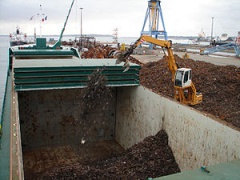Scrap metal
| Infobox on Scrap metal | |
|---|---|
| Example of Scrap metal |  |
| Facts | |
| Origin | - |
| Stowage factor (in m3/t) | Varies |
| Humidity / moisture | - |
| Ventilation | - |
| Risk factors | See text |
Scrap metal
Description / Application
Scrap consists of recyclable materials left over from product manufacturing and consumption, such as parts of vehicles, building supplies, and surplus materials. Unlike waste, scrap can have significant monetary value.
Scrap metal originates both in business and residential environments. Typically a "scrapper" will advertise their services to conveniently remove scrap metal for people who don't need it, or need to get rid of it.
Scrap is often taken to a wrecking yard (also known as a scrapyard, junkyard, or breaker's yard), where it is processed for later melting into new products. A wrecking yard, depending on its location, may allow customers to browse their lot and purchase items before they are sent to the smelters, although many scrap yards that deal in large quantities of scrap usually do not, often selling entire units such as engines or machinery by weight with no regard to their functional status. Customers are typically required to supply all of their own tools and labour to extract parts, and some scrapyards may first require waiving liability for personal injury before entering. Many scrapyards also sell bulk metals (stainless steel, etc.) by weight, often at prices substantially below the retail purchasing costs of similar pieces.
In contrast to wreckers, scrapyards typically sell everything by weight, rather than by item. To the scrapyard, the primary value of the scrap is what the smelter will give them for it, rather than the value of whatever shape the metal may be in. An auto wrecker, on the other hand, would price exactly the same scrap based on what the item does, regardless of what it weighs. Typically, if a wrecker cannot sell something above the value of the metal in it, they would then take it to the scrapyard and sell it by weight.
Great potential exists in the scrap metal industry for accidents in which a hazardous material, which is present in scrap, causes death, injury, or environmental damage. A classic example is radioactivity in scrap; see the Goiânia accident and the Mayapuri radiological accident as examples of accidents involving radioactive materials, which entered the scrap metal industry and some details of the behaviour of contaminating chemical elements in metal smelters. The general nature of many of the tools used in scrapyards such as Alligator shear, which cut metal using hydraulics give themselves the need for safety.
The metal recycling industry encompasses a wide range of metals. The more frequently recycled metals are scrap steel, iron (ISS), lead, aluminium, copper, stainless steel and zinc. There are two main categories of metals: ferrous and non-ferrous. Metals which contain iron in them are known as Ferrous where metals without iron are non-ferrous.
- Common non-ferrous metals are copper, brass, aluminum, zinc, magnesium, tin, nickel, and lead.
- Non-ferrous metals also include precious and exotic metals.
- Precious metals are metals with a high market value in any form, such as gold, silver, and platinum group metals.
- Exotic metals contain rare elements such as cobalt, mercury, titanium, tungsten, arsenic, beryllium, bismuth, cerium, cadmium, niobium, indium, gallium, germanium, lithium, selenium, tantalum, tellurium, vanadium, and zirconium. Some types of metals are radioactive. These may be “naturally-occurring” or may be formed as by-products of nuclear reactions. Metals that have been exposed to radioactive sources may also become radioactive in settings such as medical environments, research laboratories, or nuclear power plants.
OSHA guidelines should be followed when recycling any type of scrap metal to ensure safety.











